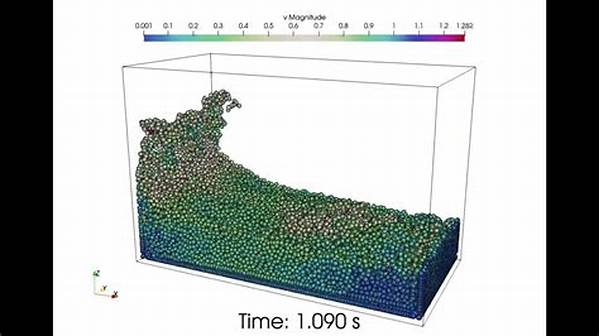Hello there, fellow curious minds and coding enthusiasts! Today, we’re diving into the fascinating world of open source particle simulation libraries. These libraries are like treasure chests for developers wanting to explore, mimic, or even predict the behavior of particles. Whether you’re just a hobbyist or a seasoned scientist, these libraries are tools that will surely boost your projects and fire up your imagination. Buckle up as we journey through this world of digital particles!
Read Now : Open License Game Graphics
Discovering Open Source Particle Simulation Libraries
Open source particle simulation libraries are like the Lego sets of the digital world, offering you the building blocks to simulate everything from dust motes floating in a sunbeam to complex molecular interactions. These libraries provide the frameworks and flexibility needed to model particle systems in a way that suits your imagination. Imagine creating a digital snowstorm, simulating the motion of celestial bodies, or modeling molecular reactions all with free access to robust computational tools.
The beauty of these open source particle simulation libraries lies in their accessibility and community-driven development. Open source implies constant improvements, innovations, and peer feedback, making them fantastic resources for learning and experimentation. They encourage collaboration and sharing, allowing you to build on solid foundations already laid by developers worldwide. Not only are you saving time and money by not starting from scratch, but you are also joining a community that’s built on the spirit of open collaboration.
Many of these libraries are highly customizable, allowing you to tweak and tinker to your heart’s content. Whether you’re working on a small personal project or contributing to something much larger, these tools can adapt to a wide array of uses. Plus, with the myriad of tutorials and forums online, learning to navigate and maximize open source particle simulation libraries has never been easier or more fun.
Top Contenders in Open Source Particle Simulation Libraries
1. Blender: Yes, the popular graphics software doubles as an open source particle simulation library! With its flexible particle physics engine, you can create everything from fire and smoke to realistic fluid simulations.
2. LAMMPS: Ideal for molecular dynamics, LAMMPS offers immense capabilities for simulating particles at the atomic level. It’s like having a mini-laboratory right on your computer!
3. Pygame: A favorite among game developers, Pygame’s open source particle libraries can render cool effects like rain, sparks, and magical glows—perfect for bringing digital environments to life.
4. OpenFOAM: Known for its impressive capabilities in computational fluid dynamics, this library can simulate the motion of fluids with unmatched precision—a fantastic tool for engineers.
5. Processing: This library makes it easy to play around with particle simulations thanks to its simple, intuitive coding language. It’s perfect for creative coders, educators, and students.
Utilizing Open Source Particle Simulation Libraries
Delving into open source particle simulation libraries opens a gateway to a universe of possibilities. Imagine a world where you can create stunning visual effects, model the physics of gaseous clouds, or even simulate astrophysical events. It’s not merely about coding; it’s about creativity and innovation.
One of the coolest things about these libraries is their ability to turn complex math into visual art. They allow programmers and developers to explore multi-dimensional data models through intuitive interfaces. Also, the strong community surrounding these libraries means you’ll never be stuck for inspiration or support. From forums to GitHub repositories, there’s a wealth of knowledge ready to be tapped into.
Harness the power of these libraries to bring your ideas to life. With a wide array of functionalities and continuous updates fueled by community contributions, they remain one of the most dynamic and engaging resources for simulation enthusiasts around the globe. You’re not just using software; you’re stepping into a world of open sharing and infinite possibilities.
Read Now : Machine Learning For Stress Analysis
The Dynamic Nature of Open Source Particle Simulation Libraries
With open source particle simulation libraries, you’re not just limited to fixed functionalities. The libraries are living entities, constantly evolving with contributions from developers worldwide. This means you get to enjoy fresh updates, features and even participate in the upgrade process, shaping the tools you use.
As new algorithms and techniques emerge in the scientific world, these libraries often incorporate cutting-edge advancements, keeping you on the frontier of technology. This highlights the robust flexibility and scalability of open source particle simulation libraries, ensuring they cater to both current needs and future innovations.
Additionally, because they are open source, these libraries often boast extensive documentation and community-driven support. Ever scratched your head over a complex feature? Fear not—there’s probably a detailed guide, tutorial, or one-on-one feedback from a fellow developer waiting for you online. It’s like having a secret club of digital inventors who are all eager to help and grow alongside you.
Community and Collaboration in Open Source Particle Simulation Libraries
The spirit of open source particle simulation libraries is collaboration. Developers from all over the globe contribute insights, improvements, and new ideas that continually revolutionize these tools. The collaborative nature leads to the creation of more comprehensive, effective, and reliable simulation platforms that could eclipse some proprietary counterparts.
Engaging with these communities also nurtures your learning and development. Whether you are contributing by writing documentation, fixing bugs, or even suggesting new features, you are an active part of a global knowledge-sharing network. This encourages learning beyond textbooks, growing real-world skills that are both inspiring and practical.
Moreover, the open-source model is fertile ground for innovation. Every contribution has the potential to spawn new directions in simulations, be it in molecular dynamics or astrophysics. As more people join this open interchange of ideas, the potential applications of particle simulations grow exponentially, turning ambitious ideas into feasible realities.
Conclusion
So there you have it—a dive into the magnetic world of open source particle simulation libraries. These digital toolkits are not merely coding frameworks; they represent a thriving ecosystem of creativity and collaboration. By embracing open source particle simulation libraries, you’re not just gaining access to powerful tools; you’re joining a global community of like-minded individuals eager to explore and innovate.
From customizing cutting-edge simulations to participating in community forums, these libraries offer something for every level of developer. Whether you’re an artist at heart looking to create stunning animations, a lead engineer wanting precise fluid dynamics simulations, or simply a curious mind exploring the potential of digital particles, there’s a place for you here.
Diving into open source particle simulation libraries offers an exciting blend of programming, art, and science. The possibilities are endless, and the journey is filled with learning, growth, and impact. So why wait? Explore the possibilities today and contribute to a digital universe that knows no boundaries!





